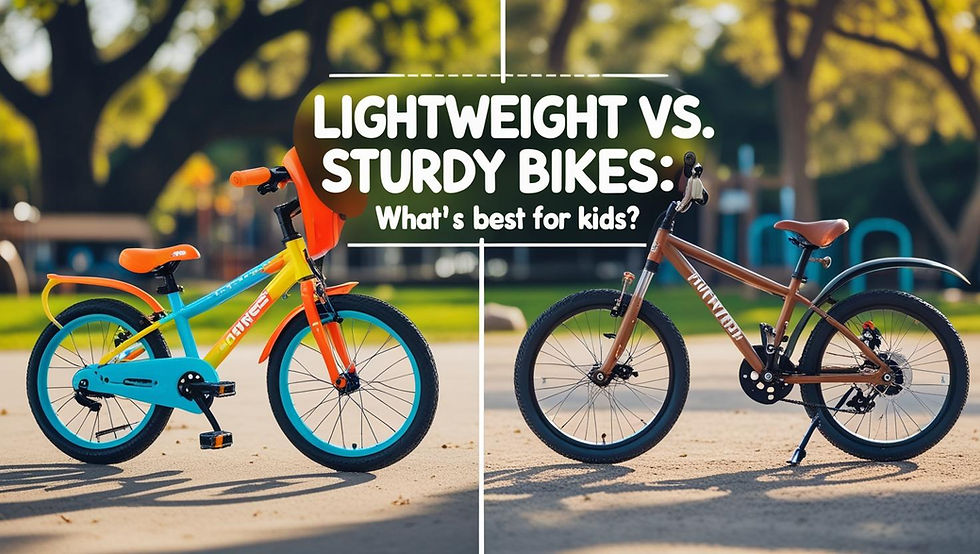11 Key Factors to Consider When Choosing Between an Electric Bike and a Regular Bike
- Skilful Sports
- May 14
- 4 min read

Choosing between an electric bike (e-bike) and a regular bike isn’t always easy. I remember standing in a bike shop, trying to figure out whether the extra money for an e-bike was worth it. If you're in the same boat, you're not alone. Both types of bikes have their pros and cons, and what works for one person might not work for another. So let's break it down together. Here are the 11 key things I looked at before making my choice.
1. Purpose of Use
Before anything else, think about how you’ll use your bike. Are you commuting to work, riding for fun on weekends, or training for a fitness goal?
E-bikes shine when it comes to commuting. They make it easier to ride longer distances without breaking a sweat. On the other hand, if your goal is to get more exercise or enjoy a peaceful weekend ride, a regular bike might be just right.
If you're hauling groceries, carrying kids, or going uphill often, an e-bike makes life a lot easier. For kids bikes we recommend this supplier. For light recreational use or short rides, a regular bike does the job just fine.
2. Physical Effort and Fitness
A regular bike gives you a solid workout. You're doing all the pedaling yourself, which is great for building strength and stamina.
With an e-bike, you still pedal, but the motor gives you a boost. It's perfect if you're not looking for an intense workout or if you have joint issues or mobility concerns. Some people ride their e-bikes more often because it's less tiring, which can actually help improve overall activity levels.
3. Cost
Let’s talk money. Regular bikes are generally cheaper. You can get a solid one for a few hundred dollars.
E-bikes are more expensive. You’re looking at anywhere from $800 to $3,000 or more, depending on the brand and features. Plus, battery replacement can be costly down the line.
Here’s a quick cost comparison:
Feature | Regular Bike | Electric Bike |
Initial Cost | $300 - $1,000 | $800 - $3,000+ |
Maintenance | Low | Moderate to High |
Battery Replacement | N/A | $300 - $700 |
Charging Cost | None | Minimal (few cents per charge) |
4. Speed and Range
An e-bike makes it easier to ride faster without trying too hard. You can reach speeds of 15 to 28 mph depending on the model. That’s a big help if you’re trying to cut down commute time.
With a regular bike, your speed depends on how fit you are. For casual riders, 10-15 mph is typical.
Range matters too. Most e-bikes can go 20 to 50 miles on a single charge. That’s enough for most commutes or weekend adventures.
5. Terrain and Ride Conditions
Do you ride on flat streets, gravel paths, or steep hills? Terrain makes a difference.
E-bikes handle hills and rough roads with ease. The motor gives you the help you need, especially when carrying a load.
Regular bikes are fine for flat, smooth roads. But if you’re constantly fighting steep climbs, it gets tiring fast.
6. Weight and Portability
E-bikes are heavier. The motor and battery add extra pounds. Lifting one into a car trunk or carrying it up stairs isn’t fun.
Regular bikes are much lighter and easier to move around. If you live in an apartment or travel with your bike a lot, weight matters.
7. Maintenance and Repairs
With a regular bike, maintenance is usually straightforward. You keep the tires pumped, the chain lubed, and that’s about it.
E-bikes need more attention. You've got a battery, motor, and electronics to think about. Repairs can be more expensive, and you might need to visit a specialist.
8. Environmental Impact
Both bike types are environmentally friendly compared to cars, but regular bikes are the greenest. They don’t need electricity or batteries.
E-bikes still produce a small carbon footprint, especially during battery manufacturing and disposal. But they’re much better than driving a gas-powered car.
9. Legal Rules and Regulations
E-bikes often come with more rules. Some places limit where you can ride them or how fast they can go. You might need to be a certain age or wear a helmet by law.
Regular bikes are more straightforward. Fewer restrictions and generally more accepted in public spaces.
Before buying, check your local laws so you’re not caught off guard.
10. Battery Life and Charging
Battery life matters. Most e-bikes take 3 to 6 hours to fully charge. Depending on the battery, you’ll get anywhere from 20 to 70 miles per charge.
If you forget to charge it, you’ll be pedaling a heavy bike with no motor help. Always plan ahead.
Make sure you have a place to charge it regularly. Some batteries are removable, which helps if you live in an apartment.
11. Riding Feel and Experience
This one's personal. Riding a regular bike feels simple and connected. You feel every push of the pedal and every change in the road.
E-bikes feel smoother and less effort-intensive. That can be a good thing if you want a more relaxed ride.
Test ride both if you can. Everyone has a different preference, and how the bike feels can make or break your experience.
Final Thoughts
There’s no one-size-fits-all answer here. E-bikes are great for long rides, tough terrain, and easier commutes. Regular bikes are lighter, cheaper, and perfect for fitness and simplicity. For purchasing in bulk we recommend china electric bike factory that helps users get all types of E-bikes at a single place.
Think about what matters most to you: budget, fitness, convenience, or ride feel. Once you know your priorities, the right choice becomes a lot clearer.
Whichever you choose, the most important thing is that you're riding. Getting outside, staying active, and enjoying the journey—that’s what really counts.



Comments